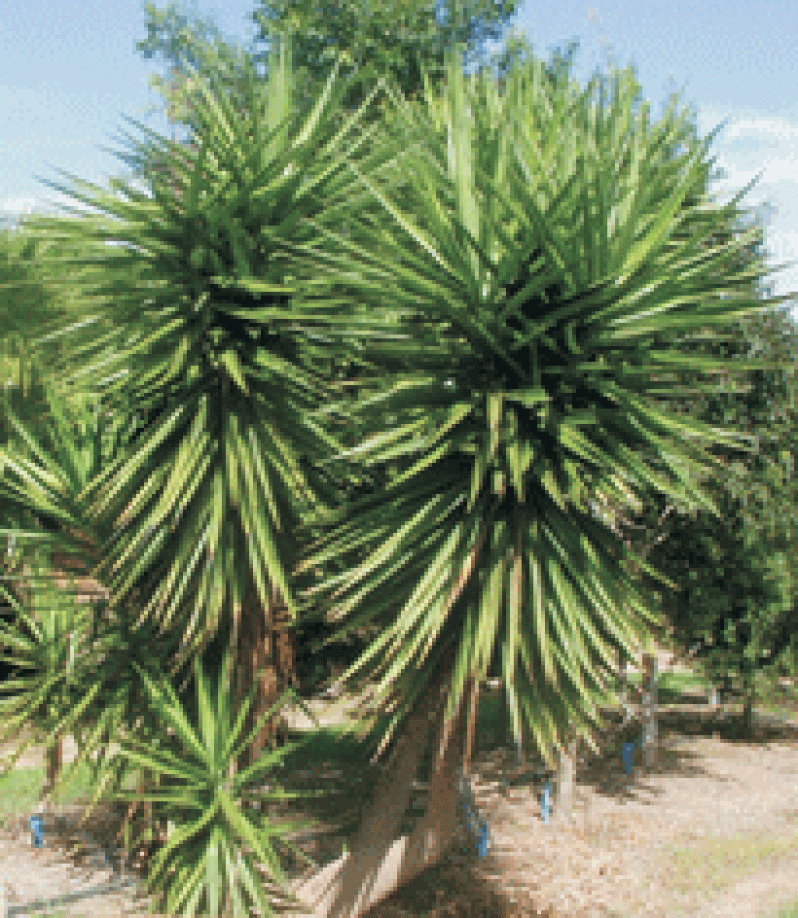Yucca: ‘The camel’ of the floras
THE YUCCA is a genus of perennial shrubs and trees in the sub-family Agavoideae of the family Asparagaceae.  Native to the hot and dry parts of North America, Central America, South America, and the Caribbean, Yucca plants are commonly cultivated as ornamentals for their unusual appearance and attractive flower clusters, and are universally planted as landscape plants, because they supposedly dramatically accentuate a landscape design.
Native to the hot and dry parts of North America, Central America, South America, and the Caribbean, Yucca plants are commonly cultivated as ornamentals for their unusual appearance and attractive flower clusters, and are universally planted as landscape plants, because they supposedly dramatically accentuate a landscape design.
Approximately 40-50 species of this plant are known to exist, of which the Yucca Elephantipes (Y.Elephantipes) is the most widely planted in Guyana. Other species, such as Y. Brevifolia, Y. Aloifolia, Y. Gloriosa, and Y. Filamentosa, are grown locally, but sightings are relatively rare.
The “yucca flower” is the state flower of New Mexico, USA.
The Yucca Elephantipes are notable for their rosettes of evergreen, tough, sword-shaped leaves, and large terminal panicles of waxy white or whitish flowers. Most species, except the Y. Elephantipes, lack a stem, but the Joshua tree (Y. Brevifolia) has a stem that is more than 33 ft (10m) high.
Our collaborators at the # 1 Plant Shop are encouraging interest in the Yucca plant this week, given the imminence of the dry season, and the fact that the Yucca thrives in drought conditions.
Private club
Very interesting to note, also, is that Yuccas have a very specialized mutualistic pollination system, being pollinated by Yucca moths only. That insect purposefully transfers pollen from the stamen of one plant to the stigma of another; and at the same time, lays an egg in the flower. The moth larva then feeds on some of the developing seeds, always leaving enough seed to perpetuate the species. The yucca can be fertilized by no other insect, and the moth can use no other plant to raise its larvae. Local horticulturalist, Hans Neher was at pains to stress that the Yucca is not a palm tree. He says that, over the years, the popular Y. Elephantipes develops a massive stem; and when the top is cut off, the plant develops several fat branches, as seen in its picture as a landscape plant. Hans advised: “If you decide to get a Yucca plant for your garden, make sure that the plant, which loves to stay solitary between shorter shrubs and annuals, gets a space of at least 6 feet width. Additionally, to prevent the plant from suffering during the rainy season, create a little mound, about 18 inches above the land and about 5 feet in diameter, where it would do much better.”
Local horticulturalist, Hans Neher was at pains to stress that the Yucca is not a palm tree. He says that, over the years, the popular Y. Elephantipes develops a massive stem; and when the top is cut off, the plant develops several fat branches, as seen in its picture as a landscape plant. Hans advised: “If you decide to get a Yucca plant for your garden, make sure that the plant, which loves to stay solitary between shorter shrubs and annuals, gets a space of at least 6 feet width. Additionally, to prevent the plant from suffering during the rainy season, create a little mound, about 18 inches above the land and about 5 feet in diameter, where it would do much better.”
The Yucca, he says, is an unpretentious plant, which will grow in almost any soil. “But for our heavy clay soil in Guyana, we advise a mix of 50% sand with 50% clay. So far, we have never experienced any problems of insect penetration of the plant, or any other growth problems.”
This popular landscape plant can be purchased in a container at the # 1 Plant Shop in Sheriff Street (Tel: 227-8094). “Pictures of larger plants which are also available for sale can be viewed at the Plant Shop, and those chosen can be professionally extracted from the nursery, delivered and planted in your garden.”
Information on the Yucca as a plant of which parts are edible, and as a plant which has medicinal uses, can be obtained on the Internet.
Hans concluded: “I wish my garden friends a dry week, (so) that we all can start to clean up and fertilize our gardens. A lot of plant and lawn fertilizers got washed out and need urgent replacement before the dry season gets into full swing.”












